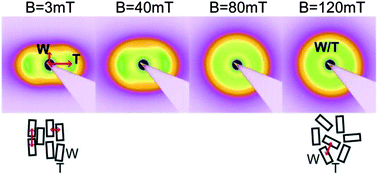Tuning biaxiality of nematic phases of board-like colloids by an external magnetic field
Abstract
We study the influence of a magnetic field on the biaxial nematic phase of board-like goethite colloids both experimentally and theoretically. Using synchrotron small angle X-ray scattering techniques we find that applying a magnetic field along the main director of the biaxial nematic phase leads to a clear decrease in biaxiality with increasing magnetic field strength. Above a certain magnetic field strength the biaxiality is completely suppressed and the biaxial nematic phase transforms into an ordinary prolate uniaxial nematic phase. In order to interpret the physical mechanism behind this phenomenon, we develop a mean-field theory for the liquid crystal phase behaviour of the suspension. Within this theory the magnetic properties of the particles are modelled by taking into account the effect of both the permanent and the induced magnetic dipoles. The resulting phase diagrams support our experimental findings of the field-induced biaxial nematic to prolate uniaxial nematic transition. They additionally predict that for more plate-like particles, which initially would only display oblate nematic ordering of the shortest axis, the rare biaxial phase can be induced by applying a magnetic field with a carefully chosen field strength, a parameter which can be easily tuned.


 Please wait while we load your content...
Please wait while we load your content...